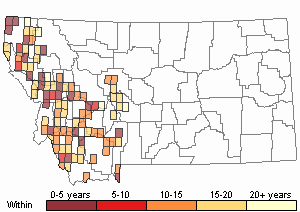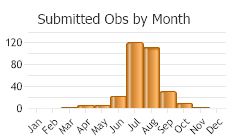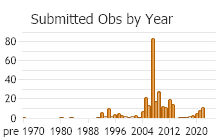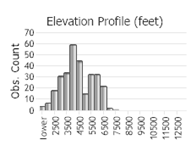View in other NatureServe Network Field Guides
NatureServe
Montana
Utah
Wyoming
Idaho
Wisconsin
British Columbia
South Carolina
Yukon
California
New York
Western Pearlshell - Margaritifera falcata
State Rank Reason (see State Rank above)
Species is found across western and isolated portions of west central Montana in cold streams and rivers. Populations are currently declining. It faces threats related to degradation of riparian areas including runoff and pollution, invasive salmonid species and warming water temperatures.
General Description
The Western Pearlshell is Montana's only coldwater trout stream mussel, and the only native mussel found on the west-side of the state (west of the Continental Divide). Populations of this mussel on the east-side of the divide in Montana reflect the declining distribution pattern of it's host fish (Westslope Cutthroat Trout). The shell of M. falcata is elongate, compressed, dark colored, and slightly concave on the ventral edge, oftentimes erosion marks are prominent on the umbo region (see photo). It has weakly developed teeth and a purple nacre (see photo). The typical size is 50 to 85 mm (2-3 inches) with larger older specimens surpassing 10 cm. In Montana, this species is similar to the introduced mussel, Ligumia recta, which is larger, thicker, has better developed teeth, pink nacre and occurs only in warmer rivers much further downstream. Since these species occur in very different habitats the likelihood of misidentifying M. falcata in Montana is virtually impossible.
Diagnostic Characteristics
"Similar to M. margaritifera except smaller (maximum length 125 mm) with purple rather than white or whitish nacre, relatively smaller anterior pseudocardinal tooth in left valve, and muscle scars in beak cavity entirely visible from below. Hermaphroditic, whereas in M. margaritifera the sexes are separate" (Clarke 1981). The shell of M. falcata is elongate, compressed, dark colored, and slightly concave on the ventral edge, oftentimes erosion marks are prominent on the umbo region (see photo). It is the smallest mussel species in Montana and the only one known west of the continental divide. It has weakly developed teeth and a purple nacre (see photo). The normal size is 50 to 85 mm with larger older specimens surpassing 10 cm. In Montana, this species is similar to Ligumia recta, which is larger, thicker, has better developed teeth, pink nacre and occurs only in warmer rivers much further downstream. Since these species occur in very different habitats the likelihood of misidentifying M. falcata in Montana is virtually impossible.
Species Range
Montana Range
Range Descriptions

 Native
Native
Range Comments
Margaritifera falcata is found in Alaska (SNR), California (S1), Idaho (S2), Montana (S2), Nevada (S1), Oregon (S3), Washington (S3), Wyoming (S3), British Columbia (S5) and was thought to have been extirpated from Utah (2010), but a small population still persists (S1) (Nature Serve 2015). Their range is widespread in area, but spotty in viable populations. Western MT was originally known as part of the species range; status of this area for the species currently needs further work (Frest and Johannes 1995). In Idaho, the historical range includes sites in the Snake, Coeur d’Alene, Lost, and Salmon River drainages (Frest and Johannes 1997, Frest 1999). Viable populations of pearlshells are persisting in north Idaho in the Coeur d’Alene, St. Joe, and St. Maries Rivers (Stagliano 2011 unpublished USFS data). In central Idaho, populations with good viability occur in the Clearwater, Selway, Lochsa, Pashimeroi, Lost, Salmon and Little Salmon rivers and in Hells Canyon. In south Idaho, populations are thought to be extant in the upper tributaries of the Snake River, including the Blackfoot River (Frest and Johannes 1997, Frest 1999). Montana’s populations of M. falcata, in contrast to Idaho’s, may be significantly contracting and becoming less viable with stream decreased flows, warming and degradation. Previously reported mussel beds in the larger rivers (Blackfoot, Big Hole, Bitterroot, Clark Fork, etc.) are extirpated from those drainages or are at such low densities, long-term viability is unlikely. This mussel species appears to have crossed the Continental Divide in Montana from west to east with its salmonid host, the Westslope Cutthroat Trout, Oncorhynchus clarki lewisi (Gustafson 2001). This is the only native trout in the Missouri River headwaters and this explains how M. falcata has reached the Smith River drainage downstream of the Missouri River. Reports of the eastern M. margaritifera in Montana are apparently due to the mistaken assumption that a mussel could not cross the Continental Divide.
Observations in Montana Natural Heritage Program Database
Number of Observations: 322
(Click on the following maps and charts to see full sized version)
Map Help and Descriptions
Relative Density

Recency



 (Observations spanning multiple months or years are excluded from time charts)
(Observations spanning multiple months or years are excluded from time charts)
Migration
Sedentary as adults, rarely move more than a few meters. As larvae (glochidia on the fish gills), they use their fish host for dispersal upstream or downstream to other suitable habitats.
Habitat
The species is found in cool and cold running streams that generally have a low to moderate gradient and are wider than 2 m; preferred habitat is stable sand or gravel substrates. It is found in hard as well as soft water, unlike M. margaritifera (Clarke 1981). In large Idaho river systems (Salmon and Clearwater River Canyons), M. falcata, attains maximum density and age in river reaches where large boulders structurally stabilize cobbles and interstitial gravels. Boulders tend to prevent significant bed scour during major floods, and these boulder-sheltered mussel beds, although rare, may be critical for population recruitment elsewhere within the river, especially after periodic flood scour of less protected mussel habitat. In Idaho's Salmon and Snake River canyon, where reaches are aggrading with sand and gravel, M. falcata is being replaced by Gonidea angulata.
Food Habits
Freshwater mussels are mostly filter-feeders, siphoning in floating particulate organic materials (small plant or animal) from the water column and straining out the particles and expel the strained water. Pedal feeding with the foot muscle has also been observed, mostly in juveniles and younger age-classes.
Reproductive Characteristics
The gravid period is from mid-May to late-June. Glochidia packets were observed from a pearlshell in the Boulder River, MT (Jefferson Basin) on June 23rd, 2015 when the water temperature was 13.5 degrees C (Stagliano 2015, unpublished data). Can be Hermaphroditic. Host fishes range-wide are the Chinook Salmon, Rainbow Trout, Brown Trout, Brook Trout, Speckled Dace, Lahontan Redside, and Tahoe Sucker. In Montana, the native host fish was solely the Westslope Cutthroat Trout. The greatest longevity so far determined for M. falcata is about 67 years, but older specimens probably occur" (Clarke 1981). Nearly all mussels (Unionidae) require a host or hosts during the parasitic larval portion of their life cycle. Hosts are usually fish species and hosts for M. falcata in this region were typically and historically Oncorhynchus spp. (Chinook Salmon, Westslope Cutthroat Trout, Steelhead, etc.), but Salmo and Salvelinus (introduced spp.) and even Rhinicthys and Catostomus (dace and suckers) are reported to be suitable.
Management
Margaritifera falcata has recently become a Sensitive Species for the USFS (2010), and has been ranked at risk (S2) in Montana since 2008. Despite earlier sharing the same state rank with Idaho, Montana’s populations have shown more dramatic declines (Gustafson, personal communication, Stagliano 2010) and were downgraded to S2 from S2S4 after more intensive sampling in 2007 and 2008 documented few viable populations in the state (Stagliano 2010). This species is widespread in geographic area, but is declining in terms of area occupied and the number of sites with viable individuals; populations showing repeated reproduction (at least several age classes) are now the exception rather than the rule (Frest and Johannes 1995, Stagliano 2010). Clarke (1993) asserted that "over-utilization of water resources by man" is responsible for the extirpation of this species in Utah. Individuals of this species can be quite long-lived; populations could exist undetected at low levels for many years without any reproduction.
Global Short Term Trend: Declining (decline of 10-30%); Global Short Term Trend Comments: Taxon is declining, in terms of area occupied and number of sites and individuals (Frest and Johannes 1995; Hoving 2004). This species has likely recently been extirpated from the Umatilla River in Oregon (Brim Box et al. 2003). Global Long Term Trend: Substantial to moderate decline (decline of 25-75%); Global Long Term Trend Comments: All 11 localities (perhaps 9 populations) in Utah have been extirpated; it formerly occurred in the northern third of the state (Oliver and Bosworth, 1999).
Stewardship Responsibility
Threats or Limiting Factors
Collection for human consumption can be a threat to some populations but harvest or possession of any freshwater mussel in Montana's Western and Central Fishing Districts is prohibited (see Montana Fishing Regulations).
Eutrophification due to agricultural runoff and siltation from improper agricultural practices are typical problems for many of the rivers in this species' range; impoundments and diversions are also continued threats (Frest and Johannes 1995). Specific threats to all populations of M. falcata, include extensive damming and diversion of rivers for irrigation, hydroelectric, and water supply projects has much reduced the WA, OR, ID, and CA range of this species. Heavy nutrient enhancement, siltation, unstable substrate, or similar problems extirpate populations. Much of the middle Snake River in Idaho is suffering from eutrophication due to agricultural runoff, fish farms, and urbanization along the river corridor. Much of the river is impounded behind a series of small dams; this is also detrimental for cold-water species such as this taxon. Fine sediment influx, generally from the same causes, is also a major problem. A recent (1994) landslide impacted some of the historic sites in the Snake River basin. In the lower Columbia River region, threats include impoundments; continued siltation and other impacts on the few remaining sites with habitat characteristics approximating pre-impoundment conditions on the lower Columbia.
References
- Literature Cited AboveLegend:
 View Online Publication
View Online Publication Brim Box, J., D. Wolf, J. Howard, C. O'Brien, D. Nez, and D. Close. 2003. The distribution and status of freshwater mussels in the Umatilla River system. Report project no. 2002-037-00 prepared for the U.S. Department of Energy, Bonneville Power Administration, Division of Fish and Wildlife, Portland, Oregon. 72 pp.
Brim Box, J., D. Wolf, J. Howard, C. O'Brien, D. Nez, and D. Close. 2003. The distribution and status of freshwater mussels in the Umatilla River system. Report project no. 2002-037-00 prepared for the U.S. Department of Energy, Bonneville Power Administration, Division of Fish and Wildlife, Portland, Oregon. 72 pp. Clarke, A.H. 1981. The freshwater molluscs of Canada. National Museum of Natural Sciences, National Museums of Canada, Ottawa. 446 pp.
Clarke, A.H. 1981. The freshwater molluscs of Canada. National Museum of Natural Sciences, National Museums of Canada, Ottawa. 446 pp. Clarke, K.R. 1993. Non-parametric multivariate analyses of change in community structure. Australian Journal of Ecology 18(1):117-143.
Clarke, K.R. 1993. Non-parametric multivariate analyses of change in community structure. Australian Journal of Ecology 18(1):117-143. Frest, T.J. 1999. A review of the land and freshwater mollusks of Idaho. Final report to the Idaho Conservation Data Center, Idaho Department of Fish and Game, Boise, Idaho. 281 pp. plus appendices.
Frest, T.J. 1999. A review of the land and freshwater mollusks of Idaho. Final report to the Idaho Conservation Data Center, Idaho Department of Fish and Game, Boise, Idaho. 281 pp. plus appendices. Frest, T.J. and E.J. Johannes. 1995. Interior Columbia Basin mollusk species of special concern. Final report to the Interior Columbia Basin Ecosystem Management Project, Walla Walla, WA. Contract #43-0E00-4-9112. 274 pp. plus appendices.
Frest, T.J. and E.J. Johannes. 1995. Interior Columbia Basin mollusk species of special concern. Final report to the Interior Columbia Basin Ecosystem Management Project, Walla Walla, WA. Contract #43-0E00-4-9112. 274 pp. plus appendices. Frest, T.J. and E.J. Johannes. 1997. An overview of Interior Columbia basin mollusk. Deixis Consultants, Seattle, Washington 98115-7125.
Frest, T.J. and E.J. Johannes. 1997. An overview of Interior Columbia basin mollusk. Deixis Consultants, Seattle, Washington 98115-7125. Gustafson, D.R. 2001. Westslope cutthroat hypothesis. Presentation to the American Fisheries Society Meeting, Bozeman, MT.
Gustafson, D.R. 2001. Westslope cutthroat hypothesis. Presentation to the American Fisheries Society Meeting, Bozeman, MT. Hovingh, P. 2004. Intermountain freshwater mollusks, USA (Margaritifera, Anodonta, Gonidea, Valvata, Ferrissia): geography, conservation, and fish management implications. Monographs of the Western North American Naturalist 2: 109-135.
Hovingh, P. 2004. Intermountain freshwater mollusks, USA (Margaritifera, Anodonta, Gonidea, Valvata, Ferrissia): geography, conservation, and fish management implications. Monographs of the Western North American Naturalist 2: 109-135. Oliver, G.V. and W.R. Bosworth, III. 1999. Rare, imperiled, and recently extinct or extirpated mollusks of Utah. Report ot the Utah Division of Wildlife Resources, Publication Number 99-29, Salt Lake City, Utah. 231 pp.
Oliver, G.V. and W.R. Bosworth, III. 1999. Rare, imperiled, and recently extinct or extirpated mollusks of Utah. Report ot the Utah Division of Wildlife Resources, Publication Number 99-29, Salt Lake City, Utah. 231 pp. Stagliano, D.M. 2010. Freshwater mussels in Montana: comprehensive results from 3 years of SWG funded surveys. Helena, MT: Montana Natural Heritage Program. 75 pp.
Stagliano, D.M. 2010. Freshwater mussels in Montana: comprehensive results from 3 years of SWG funded surveys. Helena, MT: Montana Natural Heritage Program. 75 pp.
- Additional ReferencesLegend:
 View Online Publication
View Online Publication
Do you know of a citation we're missing? Anderson, Lindsey P.. 2002/ Population genetics and conservation of the freshwater mussel, Margaritifera falcata, from the northwestern US. MS Thesis 6738. University of Montana. Missoula.
Anderson, Lindsey P.. 2002/ Population genetics and conservation of the freshwater mussel, Margaritifera falcata, from the northwestern US. MS Thesis 6738. University of Montana. Missoula. Cook, Kristen Ann. 2022. Reproductive biology and phenology of Western Pearlshell Mussels in Montana. M.S. Thesis. Montana State University, Bozeman, MT. 120 pp.
Cook, Kristen Ann. 2022. Reproductive biology and phenology of Western Pearlshell Mussels in Montana. M.S. Thesis. Montana State University, Bozeman, MT. 120 pp. Dysthe, J.C., T. Rodgers, T.W. Franklin, K.J. Carim, M.K. Young, K.S. McKelvey, K.E. Mock, and M.K. Schwartz. 2018. Repurposing environmental DNA samples - detecting the western pearshell (Margaritifera falcata) as a proof of concept. Ecology and Evolution 2018;8:2659-2670. DOI: 10.1002/ece3.3898
Dysthe, J.C., T. Rodgers, T.W. Franklin, K.J. Carim, M.K. Young, K.S. McKelvey, K.E. Mock, and M.K. Schwartz. 2018. Repurposing environmental DNA samples - detecting the western pearshell (Margaritifera falcata) as a proof of concept. Ecology and Evolution 2018;8:2659-2670. DOI: 10.1002/ece3.3898 Mock, K.E., J.C. Brim Box, J.P. Chong, J. Furnish, and J.K. Howard. 2013. Comparison of population genetic patterns in two widespread freshwater mussels with contrasting life histories in western North America. Molecular Ecology (2013) doi: 10.1111/mec.12557
Mock, K.E., J.C. Brim Box, J.P. Chong, J. Furnish, and J.K. Howard. 2013. Comparison of population genetic patterns in two widespread freshwater mussels with contrasting life histories in western North America. Molecular Ecology (2013) doi: 10.1111/mec.12557 Stagliano, David. 2019. Western Pearlshell Mussel (WEPE) Reproduction and Life History Study 2019-20 - A Very Preliminary Progress Report. Report to Montana Department of Fish, Wildlife, and Parks. Montana Natural Heritage Program. Helena, MT.
Stagliano, David. 2019. Western Pearlshell Mussel (WEPE) Reproduction and Life History Study 2019-20 - A Very Preliminary Progress Report. Report to Montana Department of Fish, Wildlife, and Parks. Montana Natural Heritage Program. Helena, MT. Test, F. C. 1891. Fish-cultural investigations in Montana and Wyoming. Annotated list of Reptiles and Batrachians collected. Bull. U.S. Fish Comm. for 1891; pp. 57-59.
Test, F. C. 1891. Fish-cultural investigations in Montana and Wyoming. Annotated list of Reptiles and Batrachians collected. Bull. U.S. Fish Comm. for 1891; pp. 57-59.
- Web Search Engines for Articles on "Western Pearlshell"
- Additional Sources of Information Related to "Mussels / Clams"





